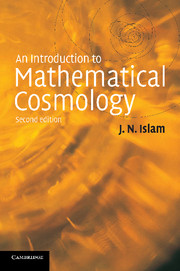Book contents
- Frontmatter
- Contents
- Preface to the first edition
- Preface to the second edition
- Dedication
- 1 Some basic concepts and an overview of cosmology
- 2 Introduction to general relativity
- 3 The Robertson–Walker metric
- 4 The Friedmann models
- 5 The Hubble constant and the deceleration parameter
- 6 Models with a cosmological constant
- 7 Singularities in cosmology
- 8 The early universe
- 9 The very early universe and inflation
- 10 Quantum cosmology
- 11 The distant future of the universe
- Appendix
- Bibliography
- Index
7 - Singularities in cosmology
Published online by Cambridge University Press: 03 February 2010
- Frontmatter
- Contents
- Preface to the first edition
- Preface to the second edition
- Dedication
- 1 Some basic concepts and an overview of cosmology
- 2 Introduction to general relativity
- 3 The Robertson–Walker metric
- 4 The Friedmann models
- 5 The Hubble constant and the deceleration parameter
- 6 Models with a cosmological constant
- 7 Singularities in cosmology
- 8 The early universe
- 9 The very early universe and inflation
- 10 Quantum cosmology
- 11 The distant future of the universe
- Appendix
- Bibliography
- Index
Summary
Introduction
In Chapter 4 we saw that all the Friedmann models have singularities in the finite past, that is, at a finite time in the past, which we have called t = 0; the scale factor R(t) goes to zero and correspondingly some physical variables, such as the energy density, go to infinity. Only exceptionally, such as in the de Sitter or the steady state models (see Fig. 6.1), is there no singularity in the finite past. But these latter models have some unphysical or unorthodox feature, such as the continuous creation of matter, which is not generally acceptable. The presence of singularities in the universe, where physical variables such as the mass-energy density or the pressure or the strength of the gravitational field go to infinity seems doubtful to many people, who therefore feel uneasy about this kind of prediction of the equations of general relativity. This was partly the motivation with which Einstein searched for a ‘unified field theory’. In this connection he says (1950):
The theory is based on a separation of the concepts of the gravitational field and matter. While this may be a valid approximation for weak fields, it may presumably be quite inadequate for very high densities of matter. One may not therefore assume the validity of the equations for very high densities and it is just possible that in a unified theory there would be no such singularity.
- Type
- Chapter
- Information
- An Introduction to Mathematical Cosmology , pp. 112 - 127Publisher: Cambridge University PressPrint publication year: 2001

